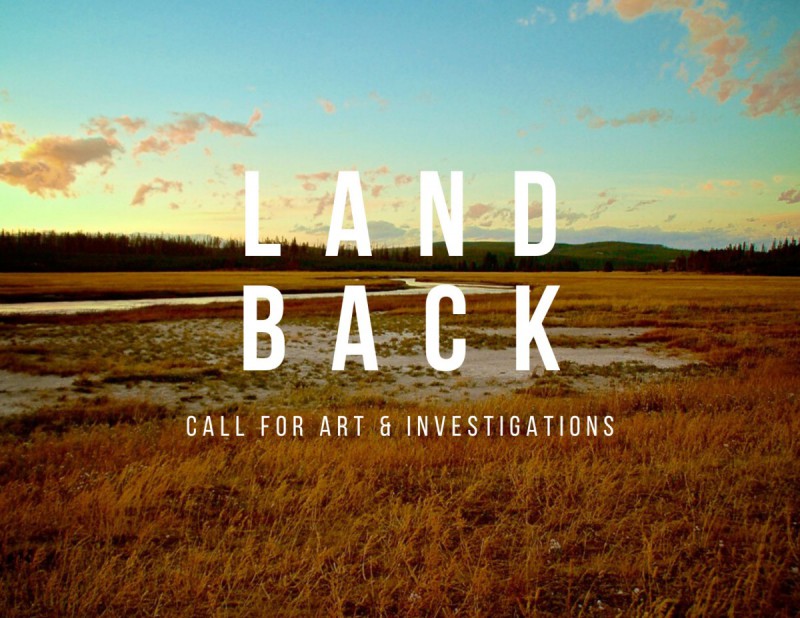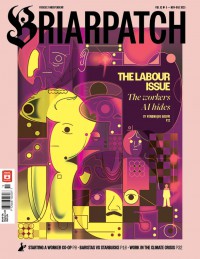Land Back issue: Call for art & investigative reporting

Last month, Briarpatch announced that in September 2020 we would be publishing a special issue on the topic of Land Back. We wanted to explore how to rightfully return land in what we sometimes know as Canada to Indigenous jurisdiction, and encourage the flourishing of Indigenous law, governance, and life on these territories. We were blown away by the pitches for personal essays, op-eds, interviews, and poetry that we received.
Now, as we build the storyboard for the Land Back issue, we need to fill in some gaps in the issue. We're looking for pitches of artwork and reporting or investigations for the Land Back issue.
Artwork
We're accepting pitches from Indigenous artists who would like to be featured in the Land Back issue. We're mainly looking for Indigenous illustrators, graphic designers, and photographers who want to create original artwork to accompany articles in the Land Back issue. But we also welcome photographs of beadwork; quillwork; sculpture; carving; basketry; painting; hide, fur, and textile art; and more.
Please send an email to pitch[at]briarpatchmagazine.com by July 1, 2020, with the subject line "Land Back Artwork." In your email you should include a link to your portfolio (Instagram is fine), or attach at least two different samples of your work. We're looking exclusively for Indigenous artists.
Our standard rates of pay are $100 for feature artwork/photographs; $50 for spot artwork/photographs; and $300 for cover artwork/photographs. We’re working to secure additional funding for artwork this issue, in which case we’ll raise our rates of pay.
Reporting and investigations
Thanks to funding from Journalists for Human Rights' Indigenous Reporters Program, we are able to offer up to six $500 bursaries for Indigenous journalists to publish reported or investigative stories in the Land Back issue.
Reported articles involve a significant amount of original research – including interviews with those directly affected and with other experts. In addition, investigative reporting involves coverage of stories that are deliberately concealed or under-reported elsewhere.
Below is an incomplete list of topic suggestions, and we invite submissions beyond these categories:
- The role of resource extraction in dispossession of land: environmental racism and pollution; corporate strategies for consulting and obtaining consent from Indigenous communities; impact and benefit agreements; resource revenue sharing; and the role of governments, financiers, courts, injunctions, and the police in facilitating resource extraction without Indigenous peoples' consent
- Other types of legal and regulatory dispossession of land: modern and historical treaties, fee simple agreements, the doctrine of discovery, private commercial contracts between Indigenous peoples and companies
- Crown sovereignty; Prairie provinces selling off provincial Crown land despite owning First Nations reserve lands through Treaty Land Entitlement
- Historical and present-day land disputes: Oka, Ipperwash, Gustafsen Lake, Burnt Church, Grassy Narrows, Caledonia, Elsipogtog, Wet’suwet’en, disputes over Treaty land
- Models of governance, consent, and management of land from different nations
- Overlapping traditional territories and jurisdictions
- Indigenous science, traditional knowledge, oral histories, and customs for stewarding and using land
- Indigenous food sovereignty and energy sovereignty
- The role of urban Indigenous communities in Land Back, including the growing presence of Indigenous-owned land in urban settings
- Indigenous ‘squatters’ and autonomous housing projects
Your pitch should describe what ground you will cover, give an estimated word count, and indicate your experience or background in writing about the issue. If you haven’t written for Briarpatch before, please provide a brief writing sample. Send your pitch to pitch[at]briarpatchmagazine.com by June 1, 2020. The bursaries are available exclusively to emerging Indigenous journalists.
Before pitching, take a look at some of our back issues to see what we have recently covered. Please review our submission guidelines and our guide to pitching.
If your pitch is accepted, a first draft of your article will be due in early July, 2020, followed by a collaborative editing process lasting until the beginning of August, 2020.
Editorial collective
The Land Back issue of Briarpatch will be edited by Briarpatch’s editor, Saima Desai – a settler living on Treaty 4 territory – with the help of three editorial collective members:
Emily Riddle is nehiyaw, a member of the Alexander First Nation in Treaty Six. She once again lives on her own territories in amiskwaciwâskahikan. She is a researcher, writer, and library worker, who sits on the board of advisors for the Yellowhead Institute, a First Nations-led think tank based out of Ryerson University.
Nickita Longman is from the George Gordon First Nation on Treaty 4 and lives as a guest in Winnipeg, Manitoba on Treaty 1 Territory. Nickita graduated from the First Nations University of Canada with a BA in English in 2013. She is a community organizer, freelance writer, and Briarpatch sustainer.
Alex Wilson, Opaskwayak Cree Nation, is a professor in the College of Education at the University of Saskatchewan. Her work focuses on land-based education, queering education, and the protection of land and water through sustainable housing.
We’re working to secure additional funding for this issue, in which case we’ll raise our rates of pay for contributors. If you’re interested in donating to increase contributors’ fees for the Land Back issue, please email publisher[at]briarpatchmagazine.com.



